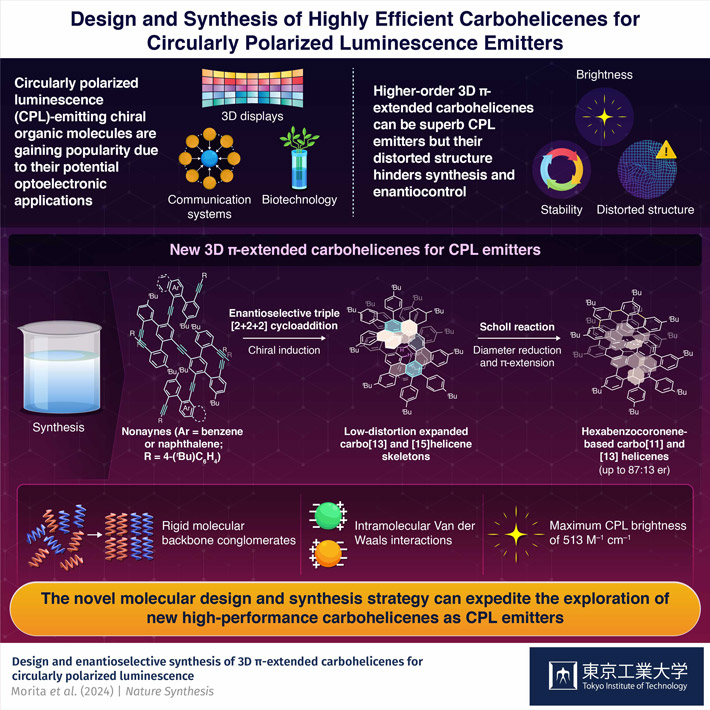Helicines are known for their excellent circularly polarized luminescence properties but synthesizing them via conventional methods often leads to distortions in the molecular structure, impacting the optical properties and stability of the molecules, an issue recently overcome by researchers from Tokyo Tech. They developed a strategy for enantioselective synthesis of carbo[11] and [13]helicenes. The synthesized materials exhibited low distortions and showed CPL brightness as high as 513 M–1 cm–1.
Helicenes are organic molecules that gained widespread popularity due to their unique helical π-conjugated molecular structure, where the benzene rings are ortho-fused, resulting in excellent chiroptical properties such as circularly polarized luminescence (CPL). The ability to act as a CPL emitter makes helicenes ideal for a wide range of next-generation optoelectronic applications, such as optical information communication systems and 3D display systems. Higher-order 3D π-extended carbohelicenes—a type of helicine—are expected to make excellent CPL emitters due to their high circular polarization, brightness, and stability. However, these exceptional properties of carbohelicenes cannot be completely exploited due to their highly distorted structure, which hinders both their synthesis and enantiocontrol— the control of the enantiomeric composition or the amount of left-handed or right-handed version of a molecule produced in a reaction.
To ensure that the full range of properties of carbohelicenes is accessible for application, a team of researchers led by Professor Ken Tanaka from Tokyo Institute of Technology recently devised a new strategy that facilitated the enantioselective synthesis of 3D π-extended carbo[11] and [13]helicenes for the CPL emitters and their enantioselective synthesis with reduced distortions.
In their 2022 study, the team reported the Rh-catalyzed enantioselective synthesis of a hexabenzocoronene-based carbo[6]helicene via intramolecular [2+2+2] cycloaddition of a triyne followed by a π-extension by the Scholl reaction. "We observed that even though this process overcame the drawbacks of conventional synthesis processes, such as unwanted rearrangement reactions and low regioselectivity, unfortunately, the molecular distortion was still pretty high. Learning from those observations, we designed a strategy to overcome the high distortions and improve CPL emission," explains Tanaka when asked about the inspiration behind their present work.
For this Nature Synthesis study, the team carried out enantioselective synthesis of carbo[11] and [13]helicenes with an enantiomeric ratio of 87:13 and overcame high distortions by combining the enantioselective synthesis of carbo[5] and [6]helicenes with triple [2+2+2] cycloaddition, which was followed by the π-extension/helix diameter reduction by the Scholl reaction. The major advantage of the stepwise construction process of a fully ortho-fused 3D π-extended carbohelicene backbone is that it overcomes the drawbacks associated with both enantioselective [2+2+2] cycloaddition and Scholl reaction.
To explore the material properties of the synthesized material, the team carried out X-ray crystallographic analyses, which revealed that the 3D π-extended carbo[11] and [13]helicenes with rigid molecular backbones were conglomerates that favored preferential crystallization. Furthermore, the most prevalent molecular forces among the carbohelicene layers were van der Waals interactions. Upon testing the photophysical properties of the synthesized π-extended carbo[11] and [13]helicenes, the team discovered that the CPL brightness reached a maximum of 513 M–1 cm–1, one of the highest values among helicene derivatives reported in the literature.
Overall, this new approach to molecular design and enantioselective synthesis can provide a solid groundwork for further research and development of high-performance carbohelicenes for CPL emitters of the future. "Our study has opened new avenues for production and adoption of chiral organic molecule-based CPL emitters, with applications ranging from state-of-the-art digital displays to efficient communication networks and essential biotechnological advancements," concludes Tanaka.
. Any information published on this site will be valid in relation to Science Tokyo.





